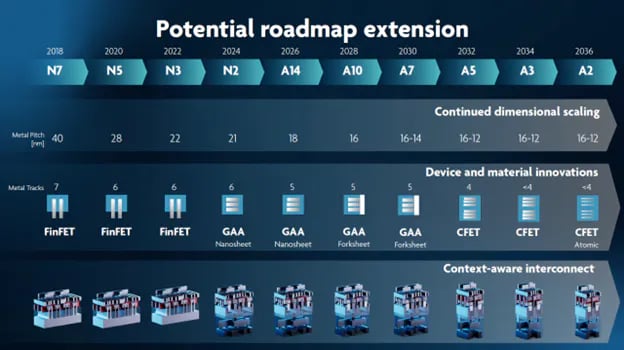Angstrom-Scale Chips: Pushing Boundaries in the Electronics Industry
Angstrom-scale ICs will require innovation across the entire semiconductor ecosystem: This will include advances in both the hardware (transistors, power distribution, and connection of multi-die systems) and tools (EDA tools with AI/ML and silicon life-cycle management).
Article co-authored by Deepak Sherlekar, Fellow in the Solutions Group at Synopsys
Every time you stream a 4K movie from your phone or play an online video game, you require bandwidth—high rates of data transfer that enable your connected devices to deliver engaging, interactive, and immersive experiences (Figure 1). Our digital world—with its increasing levels of intelligence—continues to demand more from the underlying technologies that make all these activities possible. But there are bottlenecks that threaten to thwart real-time responses.

Figure 1. Immersive experiences such as virtual reality continue to have an endless appetite for high rates of data transfer and advanced computing muscle.
Engineering ingenuity has had a way of pushing innovation forward, and the semiconductor industry has certainly been at the forefront of this push. We’ve seen Moore’s law stretched to single-digit nanometers, as designers pack billions of transistors onto a single chip to satisfy the needs of compute-intensive applications such as AI, high-performance computing, and networking. With scale and system complexities growing, nanometer-scale physical chip features may no longer suffice, paving the way for angstrom-level scaling.
At one ten-billionth of a meter, an angstrom is a unit of measurement often used to convey sizes of atoms, molecules, and, in the case of the semiconductor industry, dimensions of IC parts. In 2021, Intel was the first to lay out a process roadmap that introduced the angstrom era, anticipated to be manufacturing-ready in 2024. Meanwhile, IMEC, the independent research hub for nano and digital technologies, has outlined a transistor scaling roadmap that takes the industry to two angstroms by 2036 (Figure 2).

Figure 2. Transistor scaling roadmap to reach the angstrom scale. Image used courtesy of IMEC
Achieving the promise of angstrom-scale designs will require collaboration and ingenuity across the semiconductor ecosystem. New techniques and technologies—from innovations in lithography to new transistor structures such as gate-all-around (GAA) and complementary FET (CFET) as well as multi-die systems—have already emerged to usher in this next era of chip design.
Slowing of Moore’s Law Drives New Innovations
Under Moore’s law, chip designers have come to expect that they could double the density of their chips roughly every two years. Through ever smaller features in process technologies, design teams could still extract power, performance, and area (PPA) benefits to meet the demands of our smarter, more connected world. However, the ability to fabricate successively smaller features per Moore’s law, called feature scaling, is slowing.
Figure 3. Angstrom-level scaling is expected to enable engineers to fit more transistors on a chip and provide greater performance.
Angstrom-level scaling represents a collection of new technologies to compensate for the slowdown in feature scaling while maintaining the targets of Moore’s law, such as the doubling of transistor density with every successive process generation. With angstrom-level scaling, design engineers can fit more transistors on a chip to deliver greater performance at lower power (Figure 3).
Given the number of transistors that angstrom-scale chips will support, the future could bring:
- Manufacturing lines with more compact robotic equipment, trained to complete tasks with greater speed and precision than today’s factory automation gear
- Faster and more accurate modeling to project the impacts of climate change, ramp up new vaccine discovery, and deliver financial portfolio and risk management insights
- More efficient R&D and product design processes for industries like automotive
What angstrom scaling also does is extend the benefits of Moore’s law, providing an avenue to break through the bottlenecks that can be detrimental to chip performance.
Battling the Bottlenecks that Choke SoC Performance
It goes without saying that any lag in performance can lead to subpar results for various applications. Yet, bottlenecks do happen at various levels.
Neural networks are used in deep-learning algorithms that can recognize patterns and correlations in raw data, clustering, classifying, and learning from them for continuous improvement. These algorithms benefit from the efforts of a huge number of parallel processors. The more processors that can be placed on a piece of silicon, the faster the chip can run these massive workloads.
But chip designers must address multiple bottlenecks to achieve the PPA needed for SoCs supporting these types of applications:
- At the transistor level, there are bottlenecks around the interconnects that tie the transistors together.
- At the processor level, there’s a tradeoff between the complexity and number of processors and the amount of interconnect required to connect them, along with the need to move data swiftly between processing elements and system memory.
- At the memory level, there’s a gap because on-chip memory isn’t scaling as quickly as the size of standard cells and logic libraries. As a result, one can only extract so much out of increasingly smaller logic if the memory footprint can’t shrink along with it.
At some point, it might seem easier to have bigger processors that are easier to program and that can do more things. However, this comes with the complexity of designing and manufacturing these larger devices efficiently while simultaneously reducing the amount of achievable parallelism and increasing the power usage for simple tasks.
Angstrom-scale processes are being designed through a massive research and development exercise spanning a large number of technologies across the entire design chain, from core process definition to chip design building blocks to a suite of design automation tools and flows that enable chip design. This is made possible by:
- Augmenting traditional lithography-enabled dimensional scaling with new transistor structures
- Technologies to build digital twins of candidate transistor structures, as well as process definitions to evaluate and select the most promising ones
- New logic library and memory architectures that are building blocks of chip designs
- New algorithms in electronic design automation (EDA) tools to enable designers to implement and verify chips with exponentially larger transistor counts designed using these building blocks
Advanced Lithography
Advanced lithography tools, such as high-numerical-aperture (High-NA) extreme ultraviolet (EUV) lithography, currently under development and expected to be delivered to fabs in 2025, will enable the printing of smaller structures.
Backside Power Distribution
Moving power distribution in angstrom-scale architectures from above the transistors to under them is called backside power distribution. Backside power distribution will enable GAA structures to achieve their full density potential by enabling designers to shrink the logic cell height due to cells no longer needing wide wires, called power rails, at the top and bottom to carry power. It also frees up significant wiring resources on wiring layers above the cells, reserving the front side of the chip for signal routing and preventing the interconnects from becoming a bottleneck.
GAA and CFET
Meanwhile, GAA transistor structures allow stacking of multiple channels on top of one another to increase chip density. GAA may also allow memory scaling that is no longer possible with FinFET structures, while reducing leakage current and increasing drive current for better overall chip performance.
A more complex version of the GAA, CFETs consist of vertically stacked transistors that deliver significant area and performance benefits, especially for memories. As they are targeted for designs at 2.5nm and beyond, CFETs are anticipated to play an integral role in the angstrom era.
Chiplets
Another innovation that could go hand-in-hand with angstrom-scale dies is the multi-die system, comprised of multiple dies, often referred to as chiplets, stacked on top of one another and/or connected with an interposer, integrated in a single package. This interdependent architecture can be created through disaggregation, the partitioning of a large die into smaller dies for better system yield and cost, or by assembling dies from different process technologies for optimal system functionality and performance.
Compared to a large, monolithic SoC, a multi-die system enables accelerated scaling of system functionality, along with benefits such as reduced risk and time to market, lower system power, and the ability to rapidly create new product variants. Angstrom-sized dies could play a central role in a multi-die system, supporting the processing prowess needed for bandwidth-intensive applications, while dies at older nodes enable less taxing chip functions.
A New Way Forward for the Semiconductor Industry
The sheer volume of components being packed on chips these days is driving greater complexity into their design and verification processes. Considering billions of transistors at the angstrom scale, it’s fortuitous that AI and machine learning (ML) are being integrated into the algorithms driving EDA flows. By looking for patterns or efficiency in repetitive, large-scale tasks with orders of magnitude speed up, AI and ML can uncover, for example, a one-in-a-billion fault of interest that could be impossible to discover using legacy EDA solutions.
Similarly, ML allows applications at the front end of the implementation cycle, like synthesis, to get a good sense early on for what might happen later in the flow, so engineers can make pre-emptive decisions to guide the flow toward an optimal solution in a faster turnaround time.
In addition to AI-driven design and verification flows, silicon-proven IP can reduce integration risks while accelerating time to market for advanced semiconductor devices. Solutions such as silicon lifecycle management, with on-chip monitoring capabilities, can help track the health and performance of chips throughout their lifetime, triggering methods such as modulating supply voltage to extend the lifespan of a chip and requests for replacement before failure occurs.
As it becomes more challenging to squeeze ever greater PPA from chips, engineers continue to find ways to advance semiconductor design. Angstrom scaling can deliver chips that fuel new generations of smart, connected electronics that are impacting our world.
Industry Articles are a form of content that allows industry partners to share useful news, messages, and technology with All About Circuits readers in a way editorial content is not well suited to. All Industry Articles are subject to strict editorial guidelines with the intention of offering readers useful news, technical expertise, or stories. The viewpoints and opinions expressed in Industry Articles are those of the partner and not necessarily those of All About Circuits or its writers.







